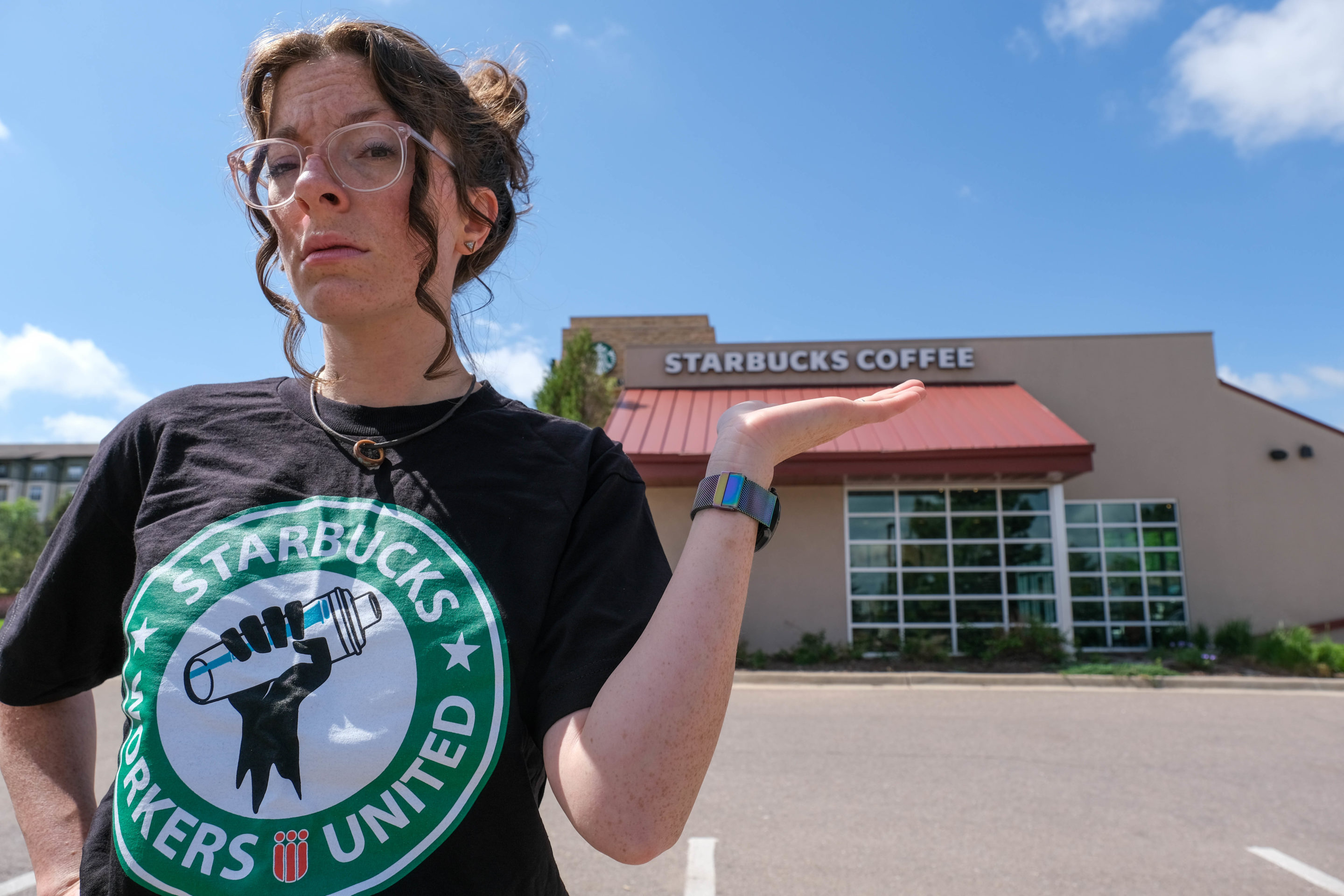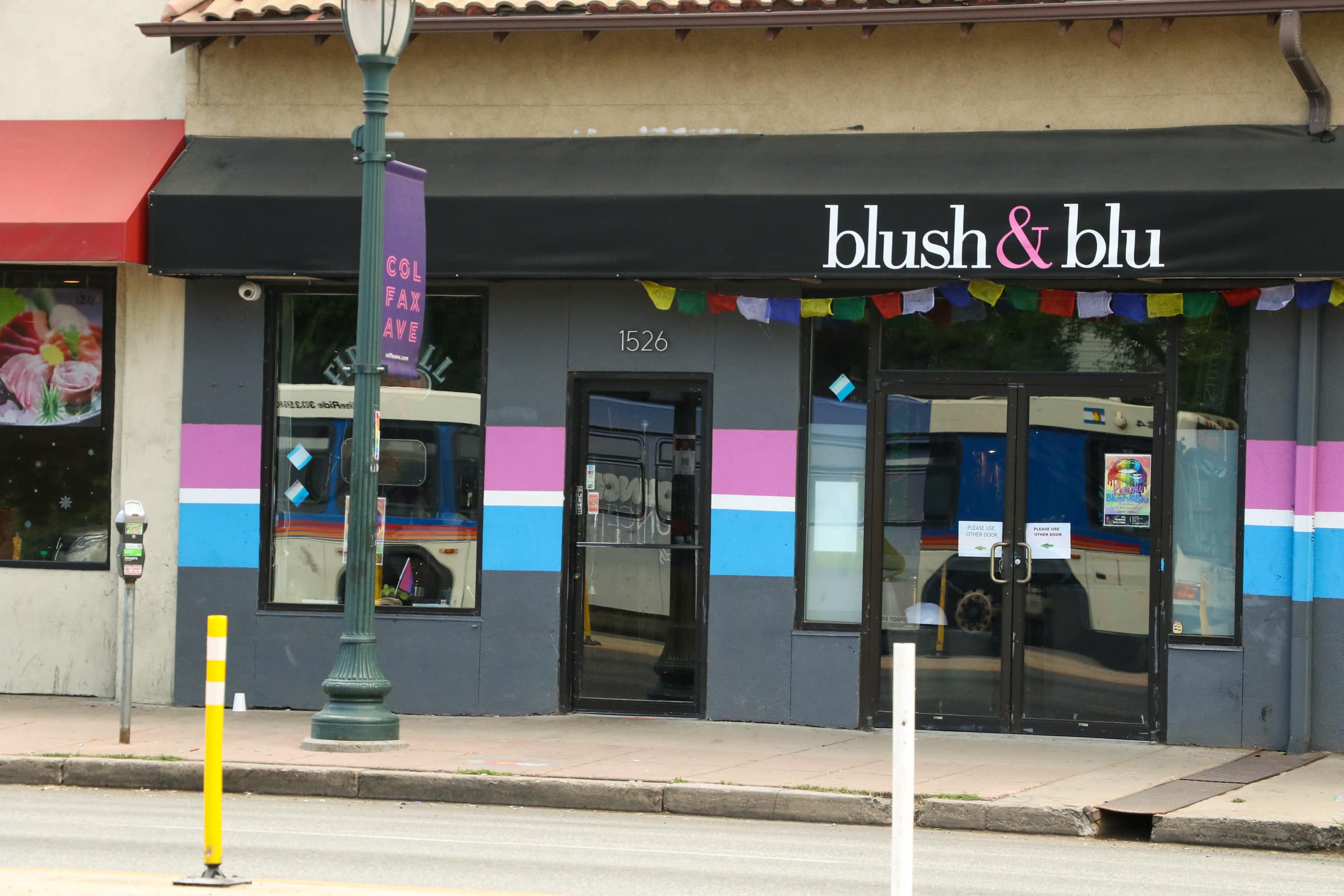//Len Harris stands outside her Starbucks in Superior, Colorado on June 7. Harris is a shift supervisor and lead union organizer for the store. Photo by Esteban Fernandez | [email protected]
In 2021, over 47 million Americans voluntarily walked away from their jobs—an unprecedented mass exit from the workforce that is now widely referred to as the Great Resignation. What followed next was a mass labor movement, with workers banding together across different industries to call for unionization.
This past April, a Starbucks in Superior, Colorado officially became the first unionized branch in The Centennial State. Since then, several other locations have followed suit.
“This was a pivotal moment not only for the store but for me personally,” said Len Harris, a shift supervisor and lead organizer for the Superior Starbucks location. “As someone who has identified as progressive, I had to step into the ideals that I claimed to hold. It was no longer enough to say it; I had to be it for the sake of all my coworkers.”
Harris speaks highly about most of her experiences working for the coffee chain. Known for its LGBTQ+ friendly environment and for attracting a younger demographic of employees, Harris returned to Starbucks after some time away because she loves her coworkers.
Returning to the chain worked out great for her until last fall when she and other employees started to see their hours cut. Harris asked for an explanation from her supervisors, but never got a concrete reason. The answers felt like excuses to Harris, especially from a company that reported record profits last year.
“There were weeks where I’d only be on the schedule for seven hours,” Harris said. “One of the things we’re hearing is that [Starbucks] can’t afford the labor, but the company is making exponential profits, so that didn’t add up to me.”
Many workers aren’t buying the math. Inflation is growing, the price of a tank of gas is ballooning and the purchasing power of the dollar is shrinking—all while hours are being cut. Many Americans like Harris are left asking how work can be reimagined. Those now a part of the Starbucks union believe that workers must unite to put pressure on large corporations while others believe union negotiations create unnecessary tension between corporations and employees.
Some academics and politicians have argued that labor unions are responsible for economic problems. Most famously, the Republican party initiated and overwhelmingly supported the Taft Hartley Act which weakened unions by prohibiting many of the tactics that made unions formidable during the 1930s and 1940s.
An argument made against unions is that they can drive up costs and lead to an adversarial relationship between labor and management. Using only union labor, which the government sometimes requires, can make big projects (think: building a new NYC subway line) more expensive.
The underlying theory by some academics is simple: When wages go up, prices follow. When prices increase, businesses will try to sell more by hiring more at higher wages. Higher wages further increase the costs of production—and thus prices—as well as demand to a point where it outpaces supply, sustaining inflationary price increases.
However, others believe that inflation is driven by corporations taking advantage of the pandemic to increase profits.
The United States recently recorded the largest jump in inflation since 1981. For the past few months, there have been debates over the sources of inflation and the proper way to contain it. At the moment, some economists insist inflation is primarily being driven by wage growth, Biden’s $1.9 trillion pandemic relief program, and the waves of stimulus checks during the pandemic.
“Inflation cycles are all similar,” said Kishore Kulkarni, a professor of economics at MSU Denver. “Employers try to hold off increasing wages, all having their own reason for why they choose to do so. And this results in employees getting uneasy which in turn causes an increase in unionization and an increase in loss of labor.”
Recent polling shows that the public is highly skeptical of corporations that claim they’ve had no choice but to raise consumer prices. Consumers question if it’s corporate greed that’s fueling this inflation.
As watchdog group Accountable US has documented over the last several months, big industries—including oil and gas, meat packing, shipping, retail, clothing, food, trucking, and railroads—have reported massive profits over the previous year, which has trickled up in the form of CEO bonuses and shareholder payouts nearing pre-pandemic levels.
“Unlike CEOs and people at the top, workers in the United States aren’t guaranteed raises, even with inflation,” Harris said. “We’re also not guaranteed healthcare and even in circumstances where it is available, like here at Starbucks, the percent the employees have to cover is still too high for us to afford it. The benefit is essentially useless.”
In fact, the Cost Of Living Adjustment for 2022 is 5.9%, while the rise of inflation currently sits at 8.6%. Two-thirds of American workers say their salaries are not keeping pace with inflation, and the percentage of employees considering quitting a job is at a four-year high, according to a new CNBC | Momentive Workforce Survey.
By driving employee retention, a claim that unions are good for business can be made. Union members earn 11% more than nonunion peers, and unions help secure critical benefits such as paid sick leave, health and safety protections and job security. While higher wages and better benefits can be costly for employers if not accompanied by increased productivity, they result in a decrease in employee turnover. A combination of better pay and benefits, more upward mobility and the ability to exercise their voices give unionized workers reason to stay.
Employee retention is critical in today’s job market, with job departures at historic highs and millions of roles unfilled. Even in a normal labor market, the cost of replacing a single low-wage worker is around 20% of annual pay; that includes direct hiring costs and the lost productivity that comes with turnover. At a company like Starbucks, which has an employee turnover of 65%, that can add up to millions of dollars each year.
While the cry for change from labor movements can be heard, for professors like Kulkarni, the answer isn’t to create more divides. There is still a belief that if workers and corporations come together, they can reach an agreement that will be more effective for everyone.
“Unions don’t allow for incentives for good employees or consequences for bad employees,” Kulkarni said. “Workers are paying into something that might not align with their individual wishes and will pit them against their employers. That’s not healthy for company dynamics.”
For workers like Harris, putting trust in their employers to fight for them is a strategy they feel they can’t trust in anymore. It has left them underpaid and overworked. By coming together as a unit, Harris believes it makes employees stronger and ensures true equity and transparency.
Now that they’ve officially unionized, their next steps are to begin negotiating. These negotiation processes will include pay, benefits, hours, leave, job health, safety policies and other issues that come up in regard to employment.
“It’s all kind of exciting,” Harris said. “While the work for what we deserve continues, we now feel like we have a voice that can be heard because we’re louder together.”
Enjoyed this story? Help us keep the lights on! Supporting local press ensures the stories you want to read keep coming, become a member for free today! Click here.





0 Comments